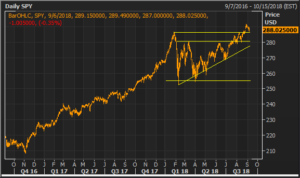Stocks have spent most of this year slowly climbing out of a hole created when they fell sharply in February and March. For technically oriented firms like ours, it is troubling when we see the major stock indexes struggling to retrace these market drops, as it suggests the overall trend might be changing (to a downtrend).
So, we were pleased to see, in late August, the S&P 500 index finally break through its January peak. Hopefully that sets the stage for continued growth as we get closer to the final lap of the year. For us, a move to new highs is encouraging because it could portend further gains ahead. Stock markets often exhibit momentum, as rising stock prices often draw in more investors which leads to more gains.
While it took seven months for the S&P 500 index to rebound and break above the high it set in January, the Nasdaq and Russell 2000 indexes reached new highs in late spring. Some indexes remain below their January peaks, including the Dow Jones Industrial Average and most international indices. It is healthy to see multiple markets moving higher together, as it suggests strong breadth (majority of stocks moving up). Currently, on a global scale, the United States shows the greatest market strength. Ultimately, we would like to see foreign markets play catch-up, but for now, we celebrate fortress America.
Does this recent action in the market mean that the happy days will continue to roll on? Not necessarily. There are a number of reasons that the stock market could face a difficult time in the period immediately ahead of us:
- September is historically the weakest month of the year for stocks, and with stocks up 7% in the past two months, it’s reasonable to expect a pause.
- Trade tariffs continue to have an impact on businesses here and abroad. This will put a damper on investor enthusiasm unless there is a meaningful resolution with China.
- The Federal Reserve is marching on with its policy of raising short-term interest rates. At some point, rising rates will begin to have a negative impact on stock prices.
- Finally, the mid-term elections are looming and the outcome could affect investors. Will the Democrats regain the House (which has been the pattern historically) and might they also regain the Senate? If they do, how will the markets react?
At this point, the FSA portfolios are close to fully invested. The average money market position across all of our strategies is only 7%. As long as stocks can continue to move above the highs reached in January, we will be looking to increase the equity allocation for each strategy up to its limit.
Overall, the economic fundamentals are quite strong, as we’ve reported in these Market Updates this year. The issue for investors is to decipher if stock prices have run ahead of the good fundamental story. So, we could be in for a period of choppiness until there is some resolution of the issues listed above. As always, our objective will be to stay with the market leaders and try to avoid any serious potholes.
Ronald Rough, CFA
Director of Portfolio Management
Disclosures: Please remember that past performance may not be indicative of future results. Different types of investments involve varying degrees of risk, and there can be no assurance that the future performance of any specific investment, investment strategy, or product (including the investments and/or investment strategies recommended or undertaken by Financial Services Advisory, or any non-investment related content, made reference to directly or indirectly in this newsletter) will be profitable, equal any corresponding indicated historical performance level(s), be suitable for your portfolio or individual situation, or prove successful. Due to various factors, including changing market conditions or applicable laws, the content may no longer be reflective of current opinions or positions.
The FSA Safety Net® is designed to represent an exit point for each security within a portfolio and to help reduce losses from sustained drops in the financial markets. The FSA Safety Net® is not effective and will not protect assets in abrupt/sudden market drops. Examples of such occurrences include, but are not limited to, the market crash of October 1987, the market drop in October 1989, the market disruption caused by the terrorist attacks of September 2001, and the flash crash of May 2010. Similar future occurrences could reduce the effectiveness of the FSA Safety Net®. In addition, the FSA Safety Net® will not protect assets in the event mutual fund companies, custodial companies, or the securities exchanges themselves, at their discretion, suspend, disallow, or fail to conduct trades, redemptions, or liquidations.
Inverse/Enhanced investments: FSA may utilize inverse (short) mutual funds and/or exchange-traded investments/funds (ETFs) that are designed to perform in an inverse (opposite) relationship to certain market indices (at a rate of one or more times the inverse result of the corresponding index). In addition, FSA may also use leveraged (enhanced) mutual funds or ETFs that provide an enhanced relationship to certain market indices (at a rate of more than one times the actual result of the corresponding index). There can be no assurance that any such investment will prove profitable or successful. In light of these enhanced risks/rewards, clients may direct FSA, in writing, not to employ any or all such investments.
Moreover, you should not assume that any discussion or information contained in this newsletter serves as the receipt of, or as a substitute for, personalized investment advice from FSA.
Financial Services Advisory is neither a law firm, accounting firm nor insurance agency and no portion of this newsletter should be construed as legal, tax, insurance or accounting advice. FSA advisors are not attorneys, accountants, insurance agents or comprehensive financial planners and no portion of its services should be construed as legal, accounting, insurance, or tax advice.
For further details, including FSA’s current Disclosure Brochure discussing our advisory services and fees, please see important disclosures at www.FSAinvest.com/disclosure. The scope of the services to be provided depends upon the needs of the client and the terms of the engagement.
Please remember that it remains your responsibility to advise FSA, in writing, if there are any changes in your personal/financial situation or investment objectives for the purpose of reviewing/evaluating/revising our previous recommendations and/or services, or if you would like to impose, add, or to modify any reasonable restrictions to our investment advisory services.





